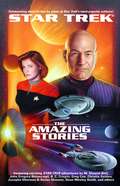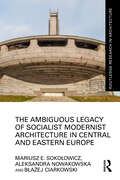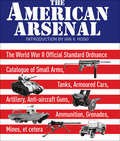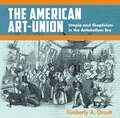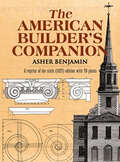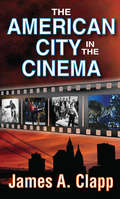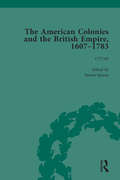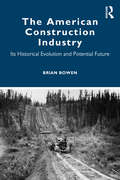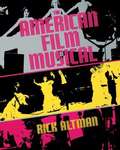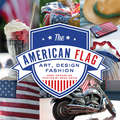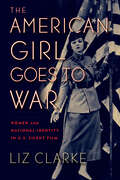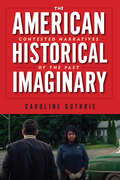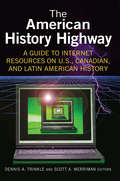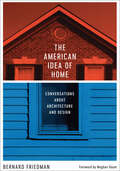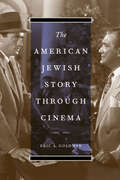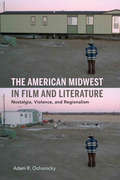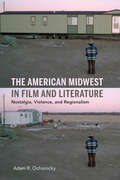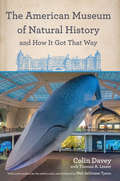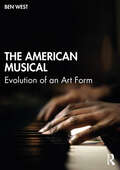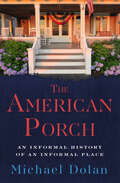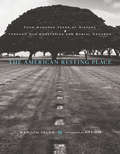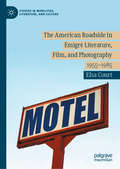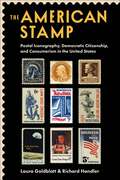- Table View
- List View
The Amazing Stories (Star Trek)
by John J OrdoverFrom 1998 to 2000, Amazing Stories, the world's oldest science fiction magazine, presented a series of original Star Trek stories written by a number of bestselling authors. Now these little-seen Star Trek adventures are collected here for the first time, together with new tales written especially for Star Trek: Amazing Stories. Among the highlights of this collection: Spock comes to terms with the death of his father in a touching tale from A.C. Cripsin, author of SAREK; Counsellor Troi risks everything to aid the evacuation of a dying planet; Seven of Nine learns a lesson in humanity when the USS Voyager takes on some unusual alien visitors; Beverley Crusher discovers that holographic doctors take some getting used to, especially during a medical emergency; and Captain Proton, Defender of the Earth, faces the awesome menace of Space Vortex of Doom.
The Ambiguous Legacy of Socialist Modernist Architecture in Central and Eastern Europe (Routledge Research in Architecture)
by Mariusz E. Sokołowicz Aleksandra Nowakowska Błażej CiarkowskiThis book examines the unique socialist-modernist architecture built in the twentieth century in Central and Eastern Europe as a source of heritage and of existing and potential value for the present and future generations. Due to the historical context in which it was created, such architecture remains ambiguous. On the one hand, the wider public associates it with the legacy of the unpleasant period of the real socialist economic regime. Yet, on the other hand, it is also a manifestation of social modernization and the promotion of a significant proportion of the population. This book focuses particularly on concrete heritage, a legacy of modernist architecture in Central and Eastern Europe, and it was this material that enabled their rebuilding after World War II and modernization during the following decades. The authors search for the value of modernist architecture and using case studies from Poland, Bulgaria, Northern Macedonia, Lithuania and Slovenia verify to what extent this heritage is embedded in the local socio-economic milieu and becomes a basis for creating new values. They argue that the challenge is to change the ways we think about heritage, from looking at it from the point of view of a single monument to thinking in terms of a place with its own character and identity that builds its relation to history and its embeddedness in the local space. Furthermore, they propose that the preservation of existing concrete structures and adapting them to modern needs is of great importance for sustainability. With increasing awareness of the issue of preserving post-war architectural heritage and the strategies of dissonant heritage management, this multidisciplinary study will be of interest to architecture historians, conservators, heritage economists, urban planners and architects.
The American Arsenal: The World War II Official Standard Ordnance Catalogue of Small Arms, Tanks, Armoured Cars, Artillery, Anti-aircraft Guns, Ammunition, Grenades, Mines, et cetera
by Ian V. HoggDuring WWII, various U.S. military agencies produced catalogues of equipment to fill the gaps left by the official War Department manuals, which led to inconsistent data appearing in different sources. In order to standardize information and properly catalogue all the equipment, the U.S. Ordnance Department put together a master guide, published here as The American Arsenal. All the information was checked and authenticated by reference to Ordnance Committee Minutes and similar authorities. No other single source provides so much accurate and authentic detail on U.S. weapons, ammunition, vehicles and other combat equipment, with an authoritative explanation of their development and introduction processes. Profusely illustrated with over 900 photographs and drawings, the facts and figures are set in context in the introduction by weapons expert Ian V. Hogg. This is an invaluable reference work for those interested in the military equipment of WWII.
The American Art-Union: Utopia and Skepticism in the Antebellum Era
by Kimberly A. OrcuttThe first comprehensive treatment in seventy years of the American Art-Union’s remarkable rise and fallFor over a decade, the New York–based American Art-Union shaped art creation, display, and patronage nationwide. Boasting as many as 19,000 members from almost every state, its meteoric rise and its sudden and spectacular collapse still raise a crucial question: Why did such a successful and influential institution fail? The American Art-Union reveals a sprawling and fascinating account of the country’s first nationwide artistic phenomenon, creating a shared experience of visual culture, art news and criticism, and a direct experience with original works.For an annual fee of five dollars, members of the American Art-Union received an engraving after a painting by a notable US artist and the annual publication Transactions (1839–49) and later the monthly Bulletin (1848–53). Most importantly, members’ names were entered in a drawing for hundreds of original paintings and sculptures by most of the era’s best-known artists. Those artworks were displayed in its immensely popular Free Gallery. Unfortunately, the experiment was short-lived. Opposition grew, and a cascade of events led to an 1852 court case that proved to be the Art-Union’s downfall. Illuminating the workings of the American art market, this study fills a gaping lacuna in the history of nineteenth-century US art. Kimberly A. Orcutt draws from the American Art-Union’s records as well as in-depth contextual research to track the organization’s decisive impact that set the direction of the country’s paintings, sculpture, and engravings for well over a decade.Forged in cultural crosscurrents of utopianism and skepticism, the American Art-Union’s demise can be traced to its nature as an attempt to create and control the complex system that the early nineteenth-century art world represented. This study breaks the organization’s activities into their major components to offer a structural rather than chronological narrative that follows mounting tensions to their inevitable end. The institution was undone not by dramatic outward events or the character of its leadership but by the character of its utopianist plan.
The American Builder's Companion: Or A System Of Architecture, Particularly Adapted To The Present Style Of Building; Illustrated With Seventy Copperplate Engravings (classic Reprint) (Dover Architecture)
by Asher BenjaminThere is scarcely a New England town which does not contain houses, church spires, or ornamental interior details derived from the Late Colonial architectural designs of Asher Benjamin (1773-1845). Benjamin disseminated his ideas chiefly through his publications, of which this book is the most important.Books such as The American Builder's Companion were written for local carpenters to be used as manuals and guides. They made it possible for small-town carpenters, who were already skilled in rudimentary carpentry and house construction, to give their buildings sophistication and style. There were instructions for raising and supporting several types of roofs, constructing winding stairs, spacing fluting evenly on columns, modeling and mounting friezes, etc. Carpenters were thus able to plan, build, and decorate complex, ornate structures.The American Builder's Companion includes rules and definitions of practical geometry and discussion of methods for drawing basic shapes and cutting them out of solids. There are designs for interior ornament -- patterns for decorative cornices, moldings, banisters, stucco ceiling ornaments, mantels, etc., as well as designs for doorways and windows. Benjamin also deals with problematic structural elements, and finally provides full plans and elevations for private houses, wooden churches, and a court house.Important as one of the single, major disseminators of a style which became almost ubiquitous in the Northeast, Benjamin's book also contains a rich store of evidence on problems and achievements of early American builders. Direct references to tools, materials, common practices and processes, and unconscious indication of taste and aesthetic values of the time will be invaluable to students of architecture, experts in restoration, and readers interested in American history and culture. New introduction by William Morgan. 70 plates.
The American City in the Cinema
by James A. ClappThe American city and the American movie industry grew up together in the early decades of the twentieth century, making film an ideal medium through which to better understand urban life. Exploiting the increasing popularity of large metropolitan cities and urban lifestyle, movies chronicled the city and the stories it generated. In this volume, urbanist James A. Clapp explores the reciprocal relationship between the city and the cinema within the dimensions of time and space.A variety of themes and actualizations have been repeated throughout the history of the cinema, including the roles of immigrants, women, small towns, family farms, and suburbia; and urban childhoods, family values, violent crime, politics, and dystopic futures. Clapp examines the different ways in which the city has been characterized as well as how it has been portrayed as a character itself.Some of the films discussed include Metropolis, King Kong, West Side Story, It's a Wonderful Life, American Beauty, Rebel without a Cause, American Graffiti, Blade Runner, Gangs of New York, The Untouchables, LA Confidential, Sunrise, Crash, American History X, Breakfast at Tiffany's, The Deer Hunter, and many more. This work will be enjoyed by urban specialists, moviegoers, and those interested in American, cultural, and film studies.
The American Colonies and the British Empire, 1607-1783, Part II vol 8
by Steven SarsonThis second part of an eight-volume reset edition, traces the evolution of imperial and colonial ideologies during the British colonization of America. It covers the period from 1764 to the end of the American Revolutionary War in 1783.
The American Construction Industry: Its Historical Evolution and Potential Future
by Brian BowenThe American Construction Industry meticulously chronicles the evolution of the construction industry from its roots in the medieval guild system to the high-tech jobsite of tomorrow. While celebrating more than two millennia of progress and innovation, this resource for students and professionals uncovers the ways of working that crossed the Atlantic with the earliest European settlers and will continue to define building trades in the United States today and in the years and decades to come. Full color illustrations bring the past to life and provide visual links to the present day.
The American Flag: Art, Design, Fashion
by Mary EmmerlingFrom the author of Eclectic Country, a patriotic collection of 200 artists&’ and designers&’ renditions of the American flag. Flags are so everywhere, so ever-present that we often barely notice them. But focused through a collector&’s vision and a photographer&’s eye, the good old red, white, and blue brings a smile, a memory, a tear and a lump to our throats. The flag is more than a symbol; it is art, and here are 200 artists&’ and designers&’ renditions of the ultimate symbol of freedom.
The American Girl Goes to War: Women and National Identity in U.S. Silent Film (War Culture)
by Liz ClarkeDuring the 1910s, films about war often featured a female protagonist. The films portrayed women as spies, cross-dressing soldiers, and athletic defenders of their homes—roles typically reserved for men and that contradicted gendered-expectations of home-front women waiting for their husbands, sons, and brothers to return from battle. The representation of American martial spirit—particularly in the form of heroines—has a rich history in film in the years just prior to the American entry into World War I. The American Girl Goes to War demonstrates the predominance of heroic female characters in in early narrative films about war from 1908 to 1919. American Girls were filled with the military spirit of their forefathers and became one of the major ways that American women’s changing political involvement, independence, and active natures were contained by and subsumed into pre-existing American ideologies.
The American Historical Imaginary: Contested Narratives of the Past
by Caroline GuthrieIn The American Historical Imaginary: Contested Narratives of the Past in Mass Culture Caroline Guthrie examines the American relationship to versions of the past that are known to be untrue and asks why do these myths persist, and why do so many people hold them so dear? To answer these questions, she examines popular sites where fictional versions of history are formed, played through, and solidified. From television’s reality show winners and time travelers, to the Magic Kingdom in Walt Disney World, to the movies of Quentin Tarantino, this book examines how mass culture imagines and reimagines the most controversial and painful parts of American history. In doing so, Guthrie explores how contemporary ideas of national identity are tied to particular versions of history that valorize white masculinity and ignores oppression and resistance. Through her explanation and analysis of what she calls the historical imaginary, Guthrie offers new ways of attempting to combat harmful myths of the past through the imaginative engagements they have dominated for so long.
The American History Highway: A Guide to Internet Resources on U.S., Canadian, and Latin American History (History Highway Ser.)
by Dennis A. TrinkleThis brand new addition to the acclaimed "History Highway" series is essential for anyone conducting historical research on North, Central, or South America. Complete with a CD with live links to sites, it directs users to the best and broadest, most current information on U.S., Canadian, and Latin American history available on the Internet. "The American History Highway": provides detailed, easy-to-use information on more than 1,700 websites; covers all periods of U.S., Canadian, and Latin American History; features new coverage of Hispanic American and Asian American History; includes chapters on environmental history, immigration history, and document collections; all site information is current and up-to-date; includes a CD of the entire contents with live links to sites - just install the disc, go online, and link directly to the sites; and, also provides a practical introduction to web-based research for students and history buffs of all ages.
The American Idea of Home: Conversations about Architecture and Design
by Bernard Friedman“Home is an idea,” Meghan Daum writes in her foreword, “a story we tell ourselves about who we are and who and what we want closest in our midst.” In The American Idea of Home, documentary filmmaker Bernard Friedman interviews more than thirty leaders in the field of architecture about a constellation of ideas relating to housing and home. The interviewees include Pritzker Prize winners Thom Mayne, Richard Meier, and Robert Venturi; Pulitzer Prize winners Paul Goldberger and Tracy Kidder; American Institute of Architects head Robert Ivy; and legendary architects such as Denise Scott Brown, Charles Gwathmey, Kenneth Frampton, and Robert A. M. Stern. The American idea of home and the many types of housing that embody it launch lively, wide-ranging conversations about some of the most vital and important issues in architecture today. The topics that Friedman and his interviewees discuss illuminate five overarching themes: the functions and meanings of home; history, tradition, and change in residential architecture; activism, sustainability, and the environment; cities, suburbs, and regions; and technology, innovation, and materials. Friedman frames the interviews with an extended introduction that highlights these themes and helps readers appreciate the common concerns that underlie projects as disparate as Katrina cottages and Frank Lloyd Wright Usonian houses. Readers will come away from these thought-provoking interviews with an enhanced awareness of the “under the hood” kinds of design decisions that fundamentally shape our ideas of home and the dwellings in which we live.
The American Idea of Home: Conversations about Architecture and Design
by Bernard FriedmanOver thirty leaders in American architecture discuss the most significant issues in the field today.&“Home is an idea,&” Meghan Daum writes in her foreword, &“a story we tell ourselves about who we are and who and what we want closest in our midst.&” In The American Idea of Home, documentary filmmaker Bernard Friedman interviews more than thirty leaders in the field of architecture about a constellation of ideas relating to housing and home. The interviewees include Pritzker Prize winners Thom Mayne, Richard Meier, and Robert Venturi; Pulitzer Prize winners Paul Goldberger and Tracy Kidder; American Institute of Architects head Robert Ivy; and legendary architects such as Denise Scott Brown, Charles Gwathmey, Kenneth Frampton, and Robert A. M. Stern. The American idea of home and the many types of housing that embody it launch lively, wide-ranging conversations about some of the most vital and important issues in architecture today. The topics that Friedman and his interviewees discuss illuminate five overarching themes: the functions and meanings of home; history, tradition, and change in residential architecture; activism, sustainability, and the environment; cities, suburbs, and regions; and technology, innovation, and materials. Friedman frames the interviews with an extended introduction that highlights these themes and helps readers appreciate the common concerns that underlie projects as disparate as Katrina cottages and Frank Lloyd Wright Usonian houses. Readers will come away from these thought-provoking interviews with an enhanced awareness of the &“under the hood&” kinds of design decisions that fundamentally shape our ideas of home and the dwellings in which we live.
The American Jewish Story Through Cinema (Jewish Life, History, and Culture)
by Eric A. GoldmanLike the haggadah, the traditional “telling” of the story of the Israelites’ exodus from Egypt that is read at the Passover seder, cinema offers a valuable text from which to gain an understanding of the social, political, and cultural realities of Jews in America. In an industry strongly influenced by Jewish filmmakers who made and continue to make the decisions as to which films are produced, the complex and evolving nature of the American Jewish condition has had considerable impact on American cinema and, in particular, on how Jews are reflected on the screen. This groundbreaking study analyzes select mainstream films from the beginning of the sound era to today to provide an understanding of the American Jewish experience over the last century. In the first half of the twentieth century, Hollywood’s movie moguls, most of whom were Jewish, shied away from asserting a Jewish image on the screen for fear that they might be too closely identified with that representation. Over the next two decades, Jewish moviemakers became more comfortable with the concept of a Jewish hero and with an overpowered, yet heroic, Israel. In time, the Holocaust assumed center stage as the single event with the greatest effect on American Jewish identity. Recently, as American Jewish screenwriters, directors, and producers have become increasingly comfortable with their heritage, we are seeing an unprecedented number of movies that spotlight Jewish protagonists, experiences, and challenges.
The American Jewish Story through Cinema (Jewish Life, History, and Culture)
by Eric A. GoldmanLike the haggadah, the traditional “telling” of the story of the Israelites’ exodus from Egypt that is read at the Passover seder, cinema offers a valuable text from which to gain an understanding of the social, political, and cultural realities of Jews in America. In an industry strongly influenced by Jewish filmmakers who made and continue to make the decisions as to which films are produced, the complex and evolving nature of the American Jewish condition has had considerable impact on American cinema and, in particular, on how Jews are reflected on the screen. This groundbreaking study analyzes select mainstream films from the beginning of the sound era to today to provide an understanding of the American Jewish experience over the last century. In the first half of the twentieth century, Hollywood’s movie moguls, most of whom were Jewish, shied away from asserting a Jewish image on the screen for fear that they might be too closely identified with that representation. Over the next two decades, Jewish moviemakers became more comfortable with the concept of a Jewish hero and with an overpowered, yet heroic, Israel. In time, the Holocaust assumed center stage as the single event with the greatest effect on American Jewish identity. Recently, as American Jewish screenwriters, directors, and producers have become increasingly comfortable with their heritage, we are seeing an unprecedented number of movies that spotlight Jewish protagonists, experiences, and challenges.
The American Midwest in Film and Literature: Nostalgia, Violence, and Regionalism
by Adam R. OchonickyHow do works from film and literature—Sister Carrie, Native Son, Meet Me in St. Louis, Halloween, and A History of Violence, for example—imagine, reify, and reproduce Midwestern identity? And what are the repercussions of such regional narratives and images circulating in American culture? In The American Midwest in Film and Literature: Nostalgia, Violence, and Regionalism, Adam R. Ochonicky provides a critical overview of the evolution, contestation, and fragmentation of the Midwest's symbolic and often contradictory meanings. Using the frontier writings of Frederick Jackson Turner as a starting point, this book establishes a succession of Midwestern filmic and literary texts stretching from the late-19th century through the beginning of the 21st century and argues that the manifold properties of nostalgia have continually transformed popular understandings and ideological uses of the Midwest's place-identity. Ochonicky identifies three primary modes of nostalgia at play across a set of textual objects: the projection of nostalgia onto physical landscapes and into the cultural sphere (nostalgic spatiality); nostalgia as a cultural force that regulates behaviors, identities, and appearances (nostalgic violence); and the progressive potential of nostalgia to generate an acknowledgment and possible rectification of ways in which the flawed past negatively affects the present (nostalgic atonement). While developing these new conceptions of nostalgia, Ochonicky reveals how an under-examined area of regional study has received critical attention throughout the histories of American film and literature, as well as in related materials and discourses. From the closing of the Western frontier to the polarized political and cultural climate of the 21st century, this book demonstrates how film and literature have been and continue to be vital forums for illuminating the complex interplay of regionalism and nostalgia.
The American Midwest in Film and Literature: Nostalgia, Violence, and Regionalism
by Adam R. OchonickyA critical overview of the evolution, contestation, and fragmentation of the Midwest’s symbolic (and often contradictory) meanings in American culture.How do works from film and literature—Sister Carrie, Native Son, Meet Me in St. Louis, Halloween, and A History of Violence, for example—imagine, reify, and reproduce Midwestern identity? And what are the repercussions of such regional narratives and images circulating in American culture? In The American Midwest in Film and Literature: Nostalgia, Violence, and Regionalism, Adam R. Ochonicky provides a critical overview of the evolution, contestation, and fragmentation of the Midwest’s symbolic and often contradictory meanings.Using the frontier writings of Frederick Jackson Turner as a starting point, this book establishes a succession of Midwestern filmic and literary texts stretching from the late-19th century through the beginning of the 21st century and argues that the manifold properties of nostalgia have continually transformed popular understandings and ideological uses of the Midwest’s place-identity. Ochonicky identifies three primary modes of nostalgia at play across a set of textual objects: the projection of nostalgia onto physical landscapes and into the cultural sphere (nostalgic spatiality); nostalgia as a cultural force that regulates behaviors, identities, and appearances (nostalgic violence); and the progressive potential of nostalgia to generate an acknowledgment and possible rectification of ways in which the flawed past negatively affects the present (nostalgic atonement). While developing these new conceptions of nostalgia, Ochonicky reveals how an under-examined area of regional study has received critical attention throughout the histories of American film and literature, as well as in related materials and discourses. From the closing of the Western frontier to the polarized political and cultural climate of the 21st century, this book demonstrates how film and literature have been and continue to be vital forums for illuminating the complex interplay of regionalism and nostalgia.“Ochonicky presents an important reading of how nostalgia shapes the Midwest in the American imagination as a place of identity and violence. Past and present slip in this compelling and well-researched approach to the workings of contemporary culture.” —Vera Dika, author of Recycled Culture in Contemporary Art and Film: The Use of Nostalgia“By centering the concept of region, Adam Ochonicky provides an insightful and refreshing reading of American popular culture. In texts ranging from Richard Wright’s Native Son to John Carpenter’s Halloween, Ochonicky demonstrates the complex terrain of the Midwest in our cultural imaginary and the diverse memories and meanings we project upon it.” —Kendall R. Phillips, author of A Place of Darkness: The Rhetoric of Horror in Early American Cinema, Syracuse University
The American Museum of Natural History and How It Got That Way: With a New Preface by the Author and a New Foreword by Neil deGrasse Tyson
by Colin DaveyThe American Museum of Natural History is one of New York City’s most beloved institutions, and one of the largest, most celebrated museums in the world. Since 1869, generations of New Yorkers and tourists of all ages have been educated and entertained here. Located across from Central Park, the sprawling structure, spanning four city blocks, is a fascinating conglomeration of many buildings of diverse architectural styles built over a period of 150 years. The first book to tell the history of the museum from the point of view of these buildings, including the planned Gilder Center, The American Museum of Natural History and How It Got That Way contextualizes them within New York and American history and the history of science. Part II, “The Heavens in the Attic,” is the first detailed history of the Hayden Planetarium, from the museum’s earliest astronomy exhibits, to Clyde Fisher and the original planetarium, to Neil deGrasse Tyson and the Rose Center for Earth and Space, and it features a photographic tour through the original Hayden Planetarium. Author Colin Davey spent much of his childhood literally and figuratively lost in the museum’s labyrinthine hallways. The museum grew in fits and starts according to the vicissitudes of backroom deals, personal agendas, two world wars, the Great Depression, and the Cold War. Chronicling its evolution―from the selection of a desolate, rocky, hilly, swampy site, known as Manhattan Square to the present day―the book includes some of the most important and colorful characters in the city’s history, including the notoriously corrupt and powerful “Boss” Tweed, “Father of New York City” Andrew Haswell Green, and twentieth-century powerbroker and master builder Robert Moses; museum presidents Morris K. Jesup, Henry Fairfield Osborn, and Ellen Futter; and American presidents, polar and African explorers, dinosaur hunters, and German rocket scientists. Richly illustrated with period photos, The American Museum of Natural History and How It Got That Way is based on deep archival research and interviews.
The American Musical: Evolution of an Art Form
by Ben WestThe American Musical is a comprehensive history of an American art form. It delivers a detailed and definitive portrait of the American musical’s artistic evolution over the course of seven distinct, newly defined eras, with a unique perspective gleaned from research at more than twenty different archives across the United States.Individual in both its approach and coverage, The American Musical traces the form’s creative journey from its 19th century beginnings, through its 20th century maturation, and to the turn of the 21st century, shedding new light on a myriad of authors, directors, and craftspeople who worked on Broadway and beyond. This book actively addresses the form’s often overlooked female and African-American artists, provides an in-depth accounting of such outside influences as minstrelsy, vaudeville, nightclubs, and burlesque, and explores the dynamic relationship between the form and the consciousness of its country.The American Musical is a fascinating and insightful read for students, artists, and afficionados of the American musical, and anyone with an interest in this singular form of entertainment.
The American Porch: An Informal History of an Informal Place
by Michael DolanThe former American History editor explores the creation and restoration of an essential part of a twentieth-century home&’s identity—the American porch. &“In this delightful look at an American icon, journalist and documentary scriptwriter . . . Dolan traces the history of the porch, using this history to explore subjects such as architecture, history, slavery, colonialism, trade, anthropology, sociology, consumer behavior, and publishing.&” —Library Journal In 1981, Michael Dolan and his wife, Eileen O&’Toole, bought a 1926 suburban bungalow in the Palisades area of Washington, DC. It was a fixer-upper and DIY project that consumed their lives for twelve years. As rooms were transformed with updated electrical wiring and plumbing, the house&’s porch became a storage area, rotating appliances, furniture, and construction materials as they were used and discarded. After the interior renovation was completed, Michael finally turned his attention to the porch, working with contractors to resurrect it—a reconstruction that inspired him to uncover the history of porches and their significance as a symbolic piece of Americana. &“In praise of the porch: Come up and sit a spell.&” —USA Today &“A wry, well-researched look at the place and the people who rocked, talked and courted on [the American porch] for three centuries.&” —Parade &“The porch is making a comeback, gradually replacing its humbler rival the deck, which the traditionalist Dolan refers to as the platform shoe or leisure suit of American architecture.&” —Time &“Dolan amply demonstrates that the porch is primarily a means of escaping the heat and, almost as important, a locus for casual social interaction.&” —Publishers Weekly
The American Resting Place: Four Hundred Years of History through Our Cemeteries and Burial Grounds
by Marilyn YalomAn illustrated cultural history of America through the lens of its gravestones and burial practices—featuring eighty black-and-white photographs.In The American Resting Place, cultural historian Marilyn Yalom and her son, photographer Reid Yalom, visit more than 250 cemeteries across the United States. Following a coast-to-coast trajectory that mirrors the historical pattern of American migration, their destinations highlight America’s cultural and ethnic diversity as well as the evolution of burials rites over the centuries.Yalom’s incisive reading of gravestone inscriptions reveals changing ideas about death and personal identity, as well as how class and gender play out in stone. Rich particulars include the story of one seventeenth-century Bostonian who amassed a thousand pairs of gloves in his funeral-going lifetime, the unique burial rites and funerary symbols found in today’s Native American cultures, and a “lost” Czech community brought uncannily to life in Chicago’s Bohemian National Columbarium.From fascinating past to startling future—DVDs embedded in tombstones, “green” burials, and “the new aesthetic of death”—The American Resting Place is the definitive history of the American cemetery.
The American Roadside in Émigré Literature, Film, and Photography: 1955–1985 (Studies in Mobilities, Literature, and Culture)
by Elsa CourtThe American Roadside in Émigré Literature, Film, and Photography: 1955–1985 traces the origin of a postmodern iconography of mobile consumption equating roadside America with an authentic experience of the United States through the postwar road narrative, a narrative which, Elsa Court argues, has been shaped by and through white male émigré narratives of the American road, in both literature and visual culture. While stressing that these narratives are limited in their understanding of the processes of exclusion and unequal flux in experiences of modern automobility, the book works through four case studies in the American works of European-born authors Vladimir Nabokov, Robert Frank, Alfred Hitchcock, and Wim Wenders to unveil an early phenomenology of the postwar American highway, one that anticipates the works of late-twentieth-century spatial theorists Jean Baudrillard, Michel Foucault, and Marc Augé and sketches a postmodern aesthetic of western mobility and consumption that has become synonymous with contemporary America.
The American Stamp: Postal Iconography, Democratic Citizenship, and Consumerism in the United States
by Richard Handler Laura GoldblattMore than three thousand different images appeared on United States postage stamps from the middle of the nineteenth century to the end of the twentieth. Limited at first to the depiction of a small cast of characters and patriotic images, postal iconography gradually expanded as the Postal Service sought to depict the country’s history in all its diversity. This vast breadth has helped make stamp collecting a widespread hobby and made stamps into consumer goods in their own right.Examining the canon of nineteenth- and twentieth-century American stamps, Laura Goldblatt and Richard Handler show how postal iconography and material culture offer a window into the contested meanings and responsibilities of U.S. citizenship. They argue that postage stamps, which are both devices to pay for a government service and purchasable items themselves, embody a crucial tension: is democracy defined by political agency or the freedom to buy? The changing images and uses of stamps reveal how governmental authorities have attempted to navigate between public service and businesslike efficiency, belonging and exclusion, citizenship and consumerism. Stamps are vehicles for state messaging, and what they depict is tied up with broader questions of what it means to be American.Goldblatt and Handler combine historical, sociological, and iconographic analysis of a vast quantity of stamps with anthropological exploration of how postal customers and stamp collectors behave. At the crossroads of several disciplines, this book casts the symbolic and material meanings of stamps in a wholly new light.
